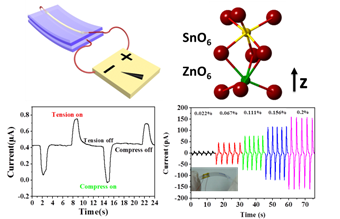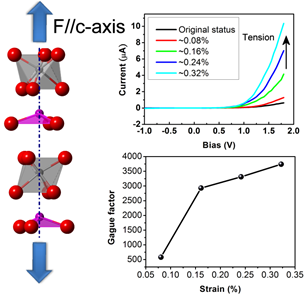Nanogenerator as a Self-powered System : Active Sensor
We demonstrated a flexible self-powered system that consists of a strain sensor and a nanogenerator. An individual ZnSnO3 microbelt was bonded at its ends to a polyethylene terephthalate (PET) substrate to fabricate a strain sensor and a single-nanobelt nanogenerator. The sensor and nanogenerator were connected in series and packaged by a polydimethylsiloxane (PDMS) layer. The ZnSnO3 belongs to a R3C point group that exhibited a large piezopotential along the z-axis, so that it can be either a power source or a sensor. The piezopotential can drive electrons to flow in the circuit and serve as a power source. The piezopotential can also tune the Schottky barrier height (SBH) at the contact by varying the tensile and compressive strain owing to the piezotronic effect, so that it can serve as a strain sensor. The output current decreased as compressive strain increased, but the current increased as tensile strain increased. The sensor can be switched by bending the flexible substrate, which can act as a highly effective reversible electromechanical switcher.

Ultrahigh Sensitive Piezotronic Strain Sensors
We demonstrated a flexible strain sensor based on ZnSnO3 nanowires/microwires for the first time. On the basis of our experimental observation and theoretical calculation, the characteristic I-V curves of ZnSnO3 revealed that our strain sensors had ultrahigh sensitivity, which is attributed to the piezopotential-modulated change in Schottky barrier height (SBH), that is, the piezotronic effect. The on/off ratio of our device is∼587, and a gauge factor of 3740 has been demonstrated, which is 19 times higher than that of Si and three times higher than those of carbon nanotubes and ZnO nanowires.

